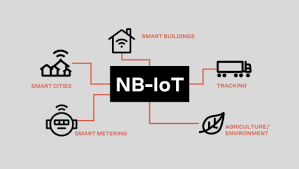Mobile Phone Technology
 image ©u-blox
image ©u-blox
4G and 5G are designed to send large amounts of data, such as streaming movies. But in an IoT environment this speed is not necessary. The demands of IoT will only a single reading (number) uploaded per day or hour. Whilst an IoT device can use 4G or even 5G, this is overkill.
NB-IoT is a simple technology than runs at 800MHz or 900MHz in Europe. This means that signal can penetrate buildings and can travel large distances. It is used in static applications, where the device sending and receiving the data does no move, Smart meters are typical applications for NB-IoT. Low data transmission and static meters. Due to their simpler protocol NB-IoT is energy efficient, many of the applications are not near main power and are operated by battery in remote locations.
- Advantages of NB-IoT
- Energy Efficiency meaning longer battery life.
- Cost effective the cost of the devices and SIM cards are low
- Building penetration, due to low frequency can penetrate buildings
- Range, again due to low frequency, so long range.
- Network stability - due to the NB-IoT using regulated frequencies
- Disadvantages
- Low data transmission rate, lower than other options such as LTE-M. Around 128kbps
- High latency, so not suitable for any real-time applications
- No data roaming, which is OK if the application is static
- No handover support - again OK if the application is static
Applications that could use LTE-M include:
- Smart meters is the application that comes to mind when thinking about NB-IoT. Meters are static, do not need to send or receive much data, nor is their any latency demands. Also in areas of low coverage this can be enhanced by better aerials.
- Smart Cities - any one of the applications that control the city infrastructure would be suitable for NB-IoT. Lighting, Parking, Traffic lights etc. Although cameras are not a suitable application
- Environmental management within cities (CO2, Smoke No2) or flood monitoring
2G is due to be switched off by 2030 (whereas 3G was switched off by 2024). There are still many applications that run on 2G, notably IoT devices both environmental and medical. NB-IoT is a candidate to take over the role of some of these applications.
© mobilephonetechnology.co.uk all rights reserved 2017-2025
